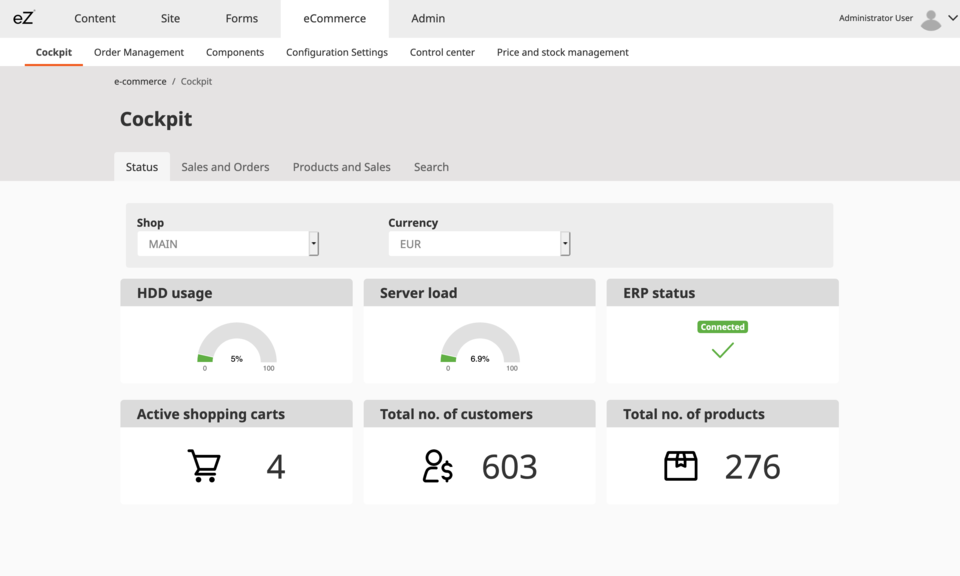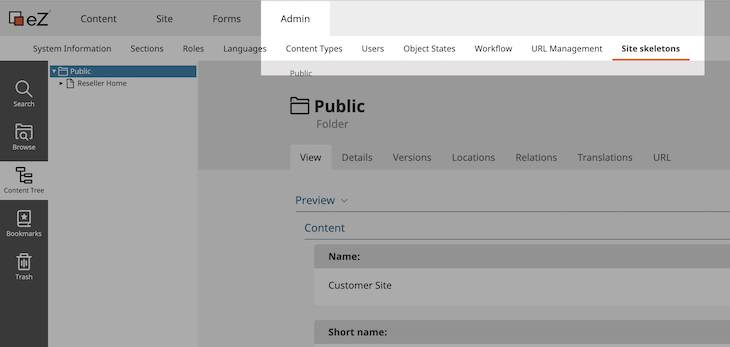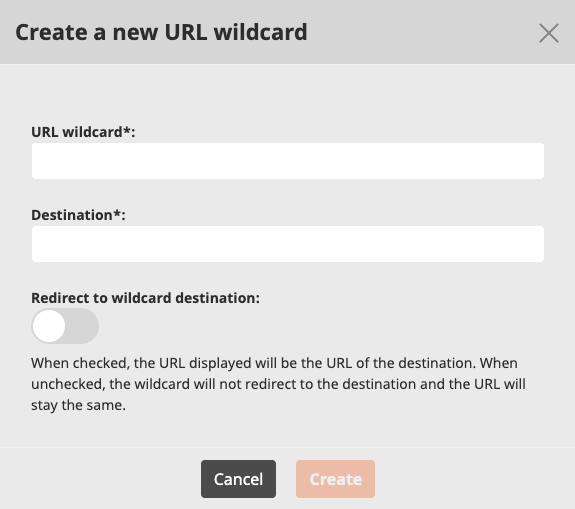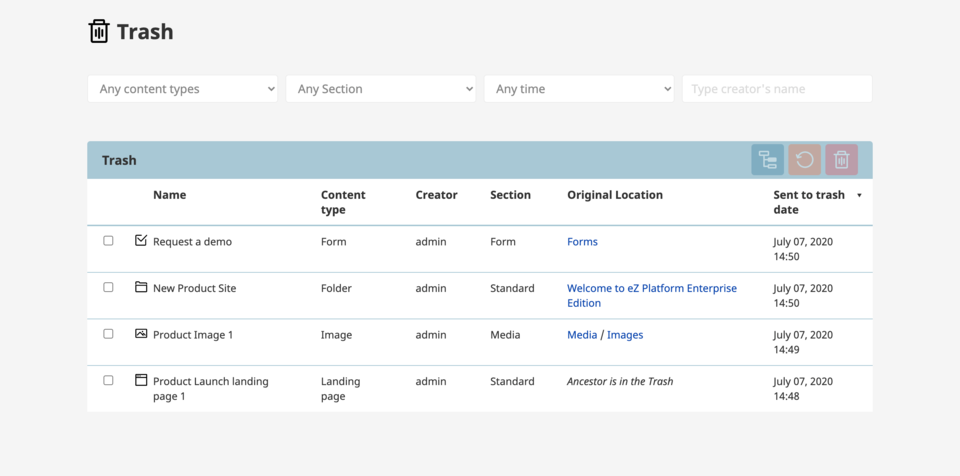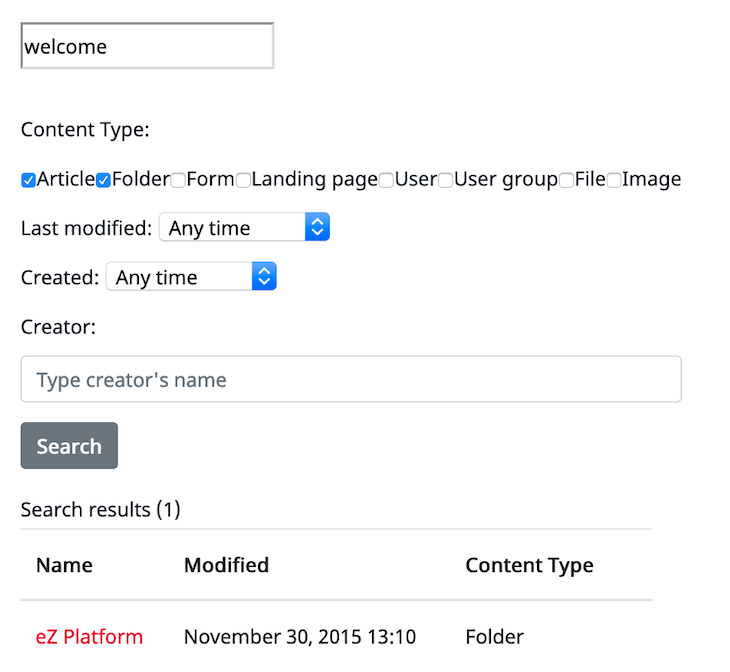Product Launch: Discover eZ Platform v3.1
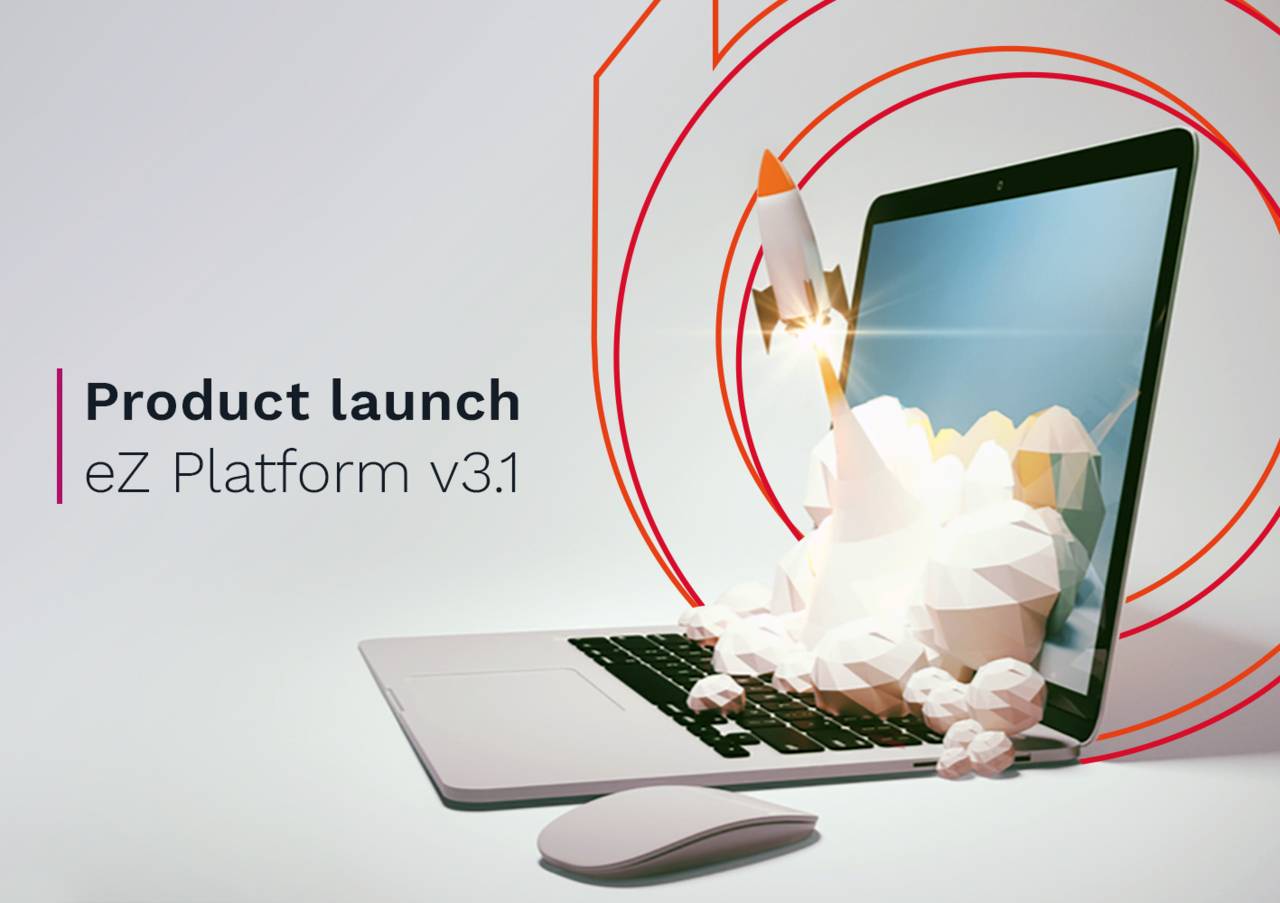
Ibexa’s latest software release, eZ Platform v3.1, offers further integration between the platform’s e-commerce and content modules, together with a host of other updates for content creators and developers.
Integrating content and commerce for a better Digital Experience Platform.
One of our key objectives for v3.1 was to more closely integrate our e-commerce solution into eZ Platform. Content is crucial to driving interactions during any digital customer journey, helping to engage and inform buyers as they move through discovery to decision.
In B2B digital journeys, efficient content operations are even more pressing. More decision-makers and influencers are engaged in the buying cycle; complex products with longer sales cycles need additional sales and product collateral (catalogs, brochures, data-sheets, technical documentation, etc); while B2B vendors must increasingly use digital channels to foster long-term business relationships to optimize repeat transactions, engage resellers, and more.
Creating and managing content for all these different touch-points with different systems managed by different teams adds friction and slows down time to market. With eZ Platform DXP, content and commerce can be managed with a single solution, while still being able to integrate with your key business systems such as ERP, PIM, or CRM.
eZ Platform E-commerce: Reconfigured
Since it was not built on Symfony 5, e-commerce was only previously available as part of the v2.5 software, and not part of eZ Platform v3.0. For this launch, we went under the hood of e-commerce and gave the engine an upgrade to supercharge your content and commerce operations to deliver digital experiences at scale.
E-commerce is now built on Symfony 5
Running on the same technology as the rest of eZ Platform means you can run all bundles and packages together:
- Extension endpoints for e-commerce now use the same technology stack as the endpoints for the rest of the eZ Platform software modules and component
- From this release and beyond, you'll always be able to run both content and commerce on the latest eZ Platform software version
Updating to v3.1 is incredibly easy
If you’re using eZ Commerce v2.5, migrating to eZ Platform DXP is fast and easy. You just need to perform a regular software update:
- Any e-commerce packages and bundles you’re using will be updated when you install the new version
- When you upgrade, you’ll still get the same functionality as eZ Commerce v2.5. For example, a connector to your ERP system, or price management will still be available.
We've completely rebuilt the admin UI
The E-commerce admin UI has been re-coded using Bootstrap, so it's built on the same framework as the admin UI for the rest of the platform:
- Easily extend and customize the Admin UI for E-commerce in the same way you can for the Admin UI in the rest of the platform
- For example, adding new tab views, update the UI branding, or add menu options for external systems you’ve integrated.
Coming next for e-commerce
As well as continuing to introduce new B2B e-commerce features, we plan to add Symfony Flex into our next release. This will make it easier to install e-commerce on your eZ Platform project.
Learn more about eZ Platform E-commerce →
New features for editors, marketing teams & content creators
Build new websites faster with new features for Site Factory:
We introduced Site Factory in v3.0 to help marketing teams bring new websites to market faster than ever before and more easily manage multiple websites at scale. For v3.1 we’ve added more advanced features to help you go to market faster than ever.
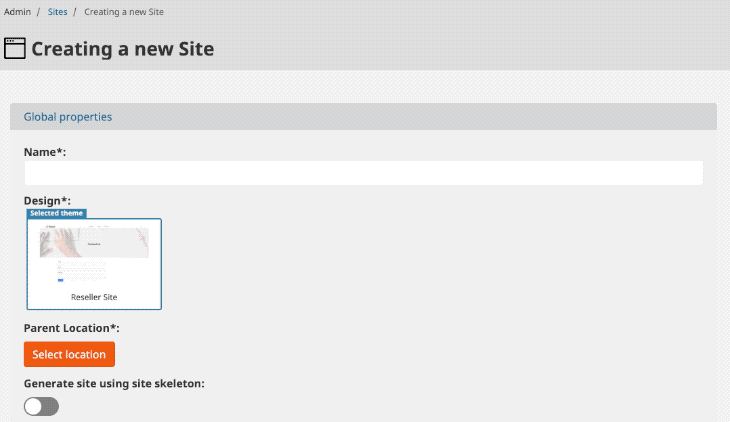
Site Skeleton: Generate new websites in just a few clicks
Read the full feature preview blog of Site Skeleton here →
Site Skeleton speeds up time-to-market by automating many configuration tasks that are usually done manually by a web developer when setting up a new website. It enables web developers to define default design themes and combine them with a predefined content architecture template.
The site skeleton generates a new site with brand-approved design and content architecture already configured and ready to go in just a few clicks. This saves marketers and editors huge numbers of hours, as they don’t have to wait for technical development for the new site.
Take, for example, a multinational organization with lots of different brands for different geographical markets. They’re able to create a site skeleton that defines:
- Link to a selected design theme (colors, logo, menu design and navigation, etc)
- Design themes provide web developers total flexibility in deciding which design options can be accessed by editors in the back-office interface, for example, whether to include an option to update the logo for a site
- A design theme can only be linked to one site skeleton at a time
- A content architecture consisting of sections for *Product*, *Blog*, *Find a store* and *Contact us*
The company can then generate a new site for each brand with this skeleton in just a few clicks in their Site Factory. And there are no limitations for how many site skeletons you can create, so it’s possible to create skeletons for many different types of sites.
Granular user permissions available in Site Factory
eZ Platform’s custom user groups let you set user permissions and access for a specific group of users. Say, for example, you want to create user groups based on location (Germany team, UK team, etc), or by job role (marketing, e-commerce, design, etc), and provide them with different permissions for publishing or deleting content, user groups let you do this.
With v3.1, User groups are available to use with Site Factory so that when you create a new website, you can assign default user groups to the new site instantly. This means you don’t have manually configure access permissions to control who can access, edit, or publish content for each new site.
Select the *Parent* location for a new site
Now, when generating a new site with Site Factory, we’ve added a new option for selecting the parent location for the new site in your *Content tree*, so you don’t have to move it manually after it’s been created.
Coming next for Site Factory:
For the next version of Site Skeleton, we’re working on adding functionality to let you add default back-office user groups to a site when you create it. When you create default user groups within eZ Platform, you can then use these to control which users have permissions to access and edit the new website, without needing to configure them for each site after you have created it.
Also, to simplify managing a lot of different websites at the same time, we plan to introduce pagination to the *Site list* view in Site Factory, as well as adding a bulk delete option to quickly remove multiple websites.
Simplify managing websites content at scale:
Version compare now includes more fields:
In our last release, we introduced the Version compare feature to compare different versions of a content item within the *Edit* interface and easily view and track changes between versions. But the last release only supported a few field types; with v3.1, we’ve updated it to include more field types out of the box:
- *Image*
- *Content relation* (single & multiple)
- *Media*
- *Image asset*
For future versions, we’re planning on extending Version compare beyond content items, to allow editors to compare versions of forms or a landing page.
Improved search with the Universal Discovery Widget
One of the fastest ways for editors to find content within the back-office system is to use eZ Platform's UDW (Universal Discovery Widget).
Filter UDW search by language:
In the last release, we added filter options to the UDW to modify your search to get more relevant results.
Now, we’ve added an extra filter option for editors to search by language.
- Previously, when using UDW, searches were always carried out in your site’s default language
- So, if your site’s default language was English and an editor used UDW to search for *bar stool*, the search results would only include content items in English related to a bar stool
- Editors would have to go to the main Search interface to get results for all language versions of content items related to bar stools
- With the new search filter, editors can select a language before performing their search
And that’s not all, as we know many of our customers are working with lots of sites and different languages, this has been a very popular feature request. So we’re back-porting this feature into previous software versions (2.5.12 and 3.0.6).
Content Tree view now added:
We've now added the ability to access the tree view in the UDW to make it quicker to locate content.
- You can now switch between the Grid, Panels and Tree views to browse and manage user accounts, media files, content items and forms
- Selections you make in one view persist when switching to alternative views.
Admin UI Improvements for more efficient editing and content collaboration
Read the full feature preview blog of Admin UI Improvements here →
We’ve made a number of updates to the Admin UI for a more seamless editorial experience and help marketing teams be more productive:
Refined text search for content blocks when using Page Builder
If you use a lot of different content blocks for your website projects, previously you needed to manually scroll through the content block options in the Page Builder’s *Elements* menu:
- We’ve now added refined text search for the *Elements* menu
- Start to type to quickly find the content block you want to add to the page
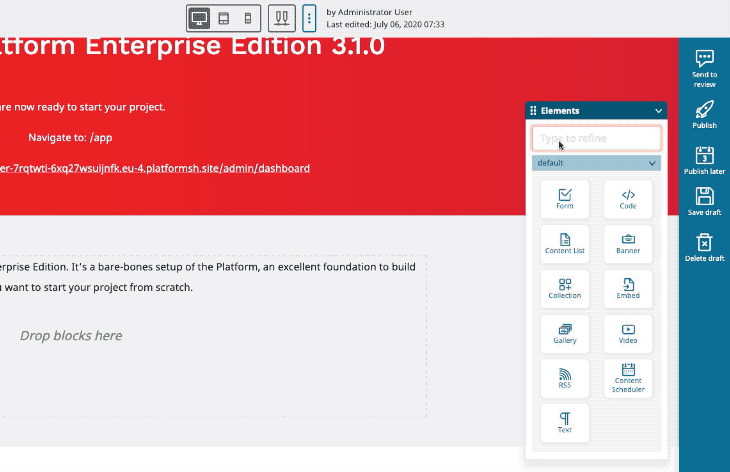
New Field Groups with user permissions in the *Edit* interface
When editing a content item, the *Edit* interface displays all the fields that make up that content type. For example, a *Product* content item might have fields for *Title*, *Image*, *Category*, *Description*etc, as well as fields for SEO metadata.
Previously, all fields were displayed in the same view:
- Now, related fields can be configured into field groups
- Each group is displayed in a separate tab view within the *Edit* interface, making it easier for back-office users to navigate to the relevant field they wish to edit
- You can then configure separate user permissions for each group
- These permissions define and limit access as to who can edit or update content in the specified field group based on their user group or user role
- For example, for your product content item, you could set up field groups for *Content*, *Product details* and *Metadata*, and restrict publishing rights for the *Product details* group to just your e-commerce team.
- These group permissions can be used to for triggering your editing and publishing workflows
- This can help manage collaboration, for example enforcing processes across distributed teams or by job function (marketing, editorial, e-commerce, design, etc).
Save an incomplete draft
When creating a new content item, usually some fields are required in order to save and create the new content item. But of course, we don’t always have every element ready when creating a new piece of content:
- Now, you can leave required fields empty and still save content as an incomplete draft, for example when preparing a blog post before you have any images ready
- The content still needs to be validated, meaning you can’t publish a draft that still has required fields empty.
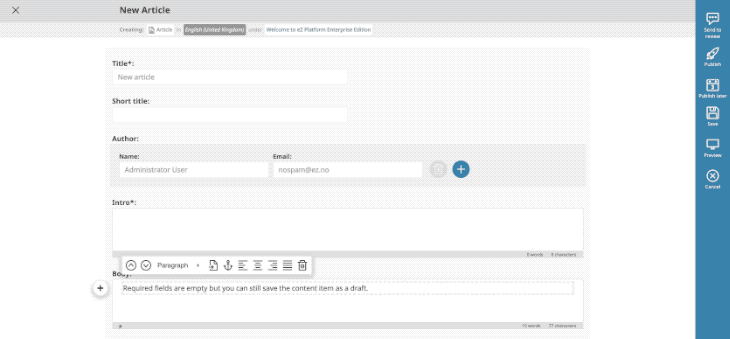
Create URL wildcards from the Admin UI
URL wildcards allow digital marketers to efficiently manage lots of content at scale and boost their SEO performance. They can help you to enforce a consistent and clear URL structure to assist search engines in understanding your site architecture, as well as create better user experiences by creating shorter, meaningful URLs to use instead of long, hard to use strings of letters and numbers,
- We’ve created a totally new URL Management interface to help digital marketers quickly and easily set up new wildcard logic without needing a developer to configure it for them.
- In the main menu, simply navigate Admin>URL Management>URL wildcards to create a new wildcard rule. Learn more about configuring and using URL wildcards with eZ Platform here.
Find Content in Trash
Marketing pros are nearly perfect. Nearly, but not quite. Very occasionally, mistakes happen, and content gets sent to trash accidentally. Being able to search through content items that have been sent to the trash folder can be very useful for admins if something has been there by mistake:
- We’ve now added a new filtering column to the Trash view, *Sent to trash date*
- This lets you sort and view items in the trash folder chronologically as well as alphabetically.
New features for developers
Search is at the heart of digital experiences as it helps to weave together content and commerce for end-users. Many of our customers have told us that as they’re increasingly combining content, products, and commerce, they need to provide advanced search capabilities to support increasingly complex user journeys and discovery paths.
As a result, for this release we have focused on enabling developers to build and design powerful search experiences with eZ Platform:
Support for Elasticsearch search engine
Read the full feature preview blog of support for Elasticsearch here →
eZ Platform already supports search via an open-source search engine, Solr. But while Solr is great for text-based searches, many of our customers have been telling us they need to support more complex search scenarios that can deliver improved search relevancy than a mainly text-based search solution can provide:
- Like Solr, Elasticsearch is an open-source search engine solution
- It’s much better suited for complex searches, as it uses aggregated data search
- This combines multiple search criteria beyond simple text-based searches to index your database and generate relevant search results
- Elasticsearch is a very developer-friendly tool. It’s a java-based solution and is very lightweight, making it perfect to scale in cloud environments
- Developers have full control in customizing how Elasticsearch indexes your eZ Platform data and how to customize search relevancy across your website(s).
Elasticsearch also enables you to build a clearly defined search strategy to help guide users along your customer journey when they perform searches. Search result pinning allows you to build rules for how search results should be prioritized based on your chosen criteria:
- You can decide a hierarchy that will always pin search results to the top of the results page based on how you prioritize your search criteria
- You can build search parameters to decide that when a user searches for *chair* on your site that results for products related to a chair are pinned to the top of the results page, and prioritized before results under Inspiration, with results under the Listings pages being prioritized last
New filtering API for back-office searches
If you’re using Elasticsearch and Solr with your eZ Platform project, this is great for delivering front-end search experiences for end-users visiting your websites or apps. However, because they’re a-synchronous solutions, this means it may take a short period for changes in your eZ Platform database (such as new content items, deleted items, etc) to be synched in the search engine index.
When using these third-party search engines for executing searches performed by admin users in the back office, errors in the search results can sometimes occur. For example, a new content item not showing up in the results, or deleted items being shown in the results by mistake. To address this, we’ve built a new filtering API:
- Implement it to execute back office searches by your admin users using content and location as search filters
- It’s similar to our previous filtering API with a key difference: it's connected directly to your eZ Platform database without synching with or using your Elasticsearch or Solr service
- This avoids synchronization issues with your database that can occasionally happen using Elasticsearch or Solr for back-office search
- Sorting and pagination of search results are supported
- In future releases, the filtering API will be available to use with the Sub-items list, Content Tree, and the Universal Discovery Widget
New search controller UI out of the box
While we always have supported front-end search in previous versions of eZ Platform, developers had to design and code their own front-end search UI for end-users to be able to perform searches on your front-end websites. In v3.1, we’ve introduced a new search controller out of the box. This provides a standard front-end search UI for your websites that end users can utilize:
- Each website is provided with a */search path*
- The search form and results are based on your content (type, date, etc)
- There’s no custom development required to get started
- But to make time-to-market faster, you can customize the standard out of the box controller rather than needing to build a custom solution from scratch for each website
- For future releases we hope to offer:
- Advanced front-end search widgets
- A *Search* content block that makes it really easy for web editors to add search interfaces to front-end websites with the Page Builder tool.
Coming next: eZ Platform v3.2
Now that we’ve shown you what’s new with this latest release, we want to give you a quick teaser for what we’ve got planned for the next release, v3.2
For v3.2 we want to continue developing our digital experience platform capabilities. We will focus on more closely integrating our personalization module into eZ Platform. This will help you more easily deliver personalized content and buying experiences for your users, and better leverage personalization data in your business processes.
We have already laid some technical foundations for this in the v3.1 release in preparation. This will allow us to work on creating new and better endpoints within the personalization module. As well as providing a more seamless user experience in the eZ Platform back office, the aim here is to let you more easily extend Personalization, for example customizing the Admin UI.
eZ Platform v3.1 downloads & resources
To see the complete overview of all the new features included in v3.1 for both the Open Source and Enterprise editions, please check out the release notes together with the change-logs on Github:
Download v3.1:
- Existing customers: download via their support portal
- Ibexa partners: download a trial instance via your partner portal login
- From ezplatform.com and via composer updates
- From eZ Platform Cloud.
We Love Your feedback
We're passionate about building products that help your digital business grow. Do you have a great idea for a feature that should be added to eZ Platform? Or just want to give us some feedback on a current feature?
Head to our Product Roadmap page to submit your request.
eZ Platform is now Ibexa DXP
Ibexa DXP was announced in October 2020. It replaces the eZ Platform brand name, but behind the scenes it is an evolution of the technology. Read the Ibexa DXP v3.2 announcement blog post to learn all about our new product family: Ibexa Content, Ibexa Experience and Ibexa Commerce

